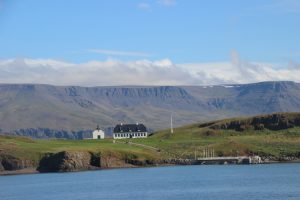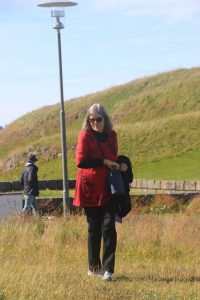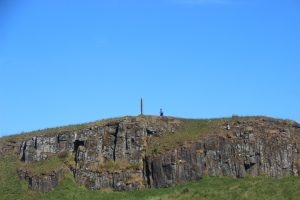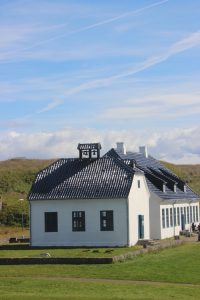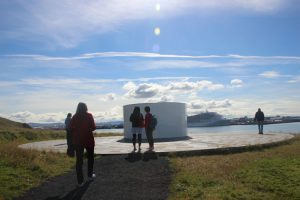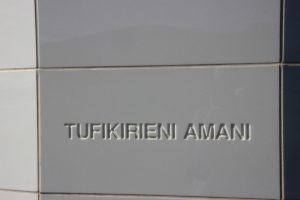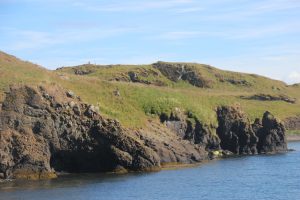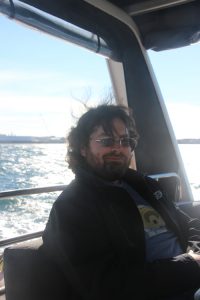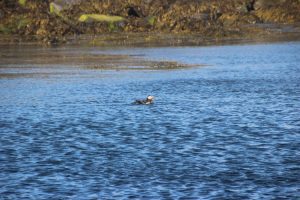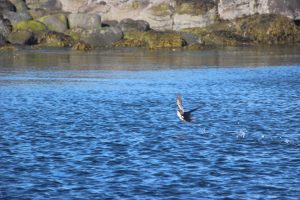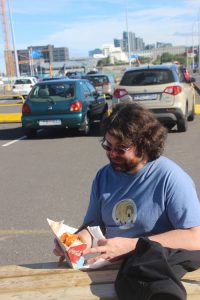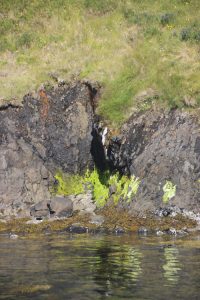The ferry ride from the Videy terminal to Videy island was the most surprising of the day trips. In one of our pre-trip planning conversations Linda said that the Videy ferry ride provided one of the best opportunities to see whales and seabirds. When Linda and Daniel arrived, I had already seen puffins and whales but I was certainly up for seeing more.
It took us a while to find the ferry site; we got to the terminal area, east of the Old Harbor, quite easily but this is also a berth for some cruise ships and, I suspect, a couple of larger ferries, and we drove around for a few minutes looking for the Videy office. It faked us out; it was a small one-room building tucked into a corner, looking out over a narrow channel at a lush green spit of land that hosted a picturesque building. I took some pictures while we waited for the ferry, which was quite small. They loaded us on. There were seats atop the cockpit and the boat, fully loaded, would probably hold about 20 people. We chose to hang out on deck. The little boat backed up, veered in a circled, and motored forward to a landing on the spit. It took about ten minutes. I thought maybe we picked up more passengers before heading off to Videy.
We watched people disembarking, and Daniel turned to the young woman with a bike who was standing next to us. “Is this Videy Island?”
“I hope so,” she said.
It was Videy Island.
(You’re asking yourself, “Why didn’t Marion look at a map?” I had looked at a map. It would be accurate to say I hadn’t paid attention to the map.
As for the whale and bird watching, the Videy Island ferry also leaves from the Old Harbor. From that location you come all the way across the bay, and bird-watching would be excellent. I don’t know that you’d see whales, but the odds of seeing dolphins would be very good.)
Videy holds quite a lot of Icelandic history. It was the site of a Catholic monastery from about the year 1,000 until the Wars of Religion, when the Danish king declared Protestantism the religion of the land and evicted the monks (Iceland was a Danish possession). Later various political personages built homes on the island. It is mostly flat, shaped like a stretched out figure eight, with three low rolling hills; a nesting place for seagulls and arctic terns. It is filled with geese, and goose scat. I mean filled; watch your step.
The picturesque building is the museum cum restaurant, and next to it is the small painted church.
We walked to the north side to see Yoko Ono’s Imagine Peace tower. If Linda hadn’t told me this was a monument, I would have assumed it was a water cistern. Up close, you can see that it is made of glossy white tiles with the words “Imagine Peace,” in various languages, stamped on each one. Our guide told us that in the fall/winter, this monument is impressive indeed. From October 9, John Lennon’s birthday, through December 7, the date he was murdered, lights in the base of the memorial shine up into the sky, providing a beacon of peace and hope. The guide said that Yoko Ono chose Iceland in part because so much of their energy comes from geothermal. No one, Ono said, has fought a war over that energy source.
The north end of the island also has a boathouse. At the south end, the remains of a couple of homesteads remain; on two occasions, different people tried to set up fishing operations on the island. Neither was a success. The second one fell victim to the worldwide economic depression of the 1930s.
From there we drove back to the Old Harbor and took a boat ride to see puffins. The puffin tours were winding down. The adult birds are about to go back to the deep ocean where they spend eight months of the year. At Akurey we saw none, but our captain took us farther out to another island, and there they were.
I had coffee (Linda and Daniel had nothing) at Café Haiti, which is along the waterfront of the Old Harbor. We admired Harpa some more. Daniel tried Icelandic fish and chips from a food truck. He declared that they were “okay.” Icelandic fish and chips is a “thing,” which should come as no surprise in a country whose number one industry is fishing.


